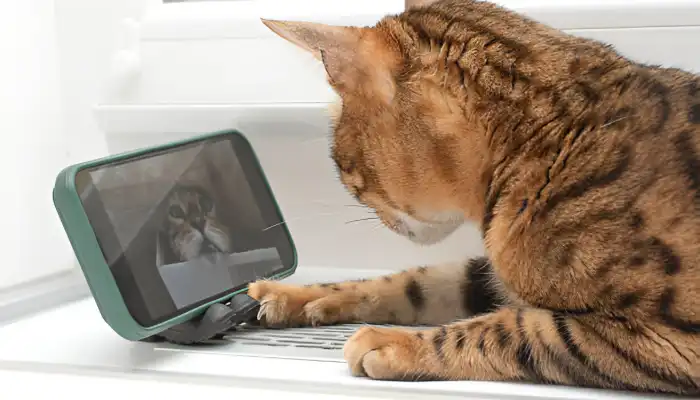How to speak cat translator – Have you ever wondered if is it possible to decode cat language? Many wonder if we can truly understand our feline companions, and the answer lies somewhere between science, technology, and observation. While devices and cat translator apps have tried to translate the complex sounds of cats, they are far from perfect.
This article explores the latest advancements in cat language translation, how cats communicate through their vocalizations and body movements, and how you can start to interpret your cat’s messages more effectively.

How to Speak Cat Translator: Basics of Cat Language
Before we move to the main query, let us first understand the basics of cat communication. Let’s have a look at how cats use different sounds and body language to communicate their thoughts.
The Science of Cat Language
- Cat Sounds: As we know, cats make a whole host of sounds, such as meowing, growling, purring, and chirruping. Each sound serves a different purpose and expresses a range of emotional responses. Learning how to speak human to cat translator can help you understand what these sounds mean and how they reflect your cat’s feelings.
- Studies and Research: Cat sounds have been studied for over a hundred years now, focusing on the reactions from humans. People, for instance, cannot hear what cats are saying, yet they know some sounds emphasize a need for food or petting.
Software And Tools For Translation
- Launching Cat Apps: In recent years, several applications have sprouted that aid in translating cat sounds to human speech. Some use tone and pitch to determine what is being said using the amplitude of the meow.
- The reality of these Apps: As stated earlier, some applications may provide moments of humor, but none are genuinely capable of understanding the layered complexity of strategic feline communication.
The tech world is advancing, but the riddle of how to speak cat translator is yet to be solved. The nature of animal communication is far more advanced than what exists today.

Can Devices Translate Cat Sounds?
It is both remarkable and puzzling to consider whether there are devices or software that can assist in speaking cats. While some of the newer apps attempt to interpret cat sounds, they do not understand what cats actually ‘say’.
There have been some attempts to try to “interpret” cat sounds as part of learning how to speak cat translator. These devices listen to the meow of your cat and attempt to analyze it. The two famous ones are:
- MeowTalk: This app tries to identify pitch. Specifically, it tries to determine ‘high’ versus ‘low’ pitched meows, after which the user is presented with different options ranging from “I’m starving” to “Cuddle me” and everything in between.
- Chatterbox: This app appears to perform more or less the same functions as MeowTalk, although it does so by searching through a database for interpreted sounds that portray cat meows.
| App | Specification | Outcome |
|---|---|---|
| MeowTalk | Tries to attach meaning to your cat’s meow | Does not work for most cases that involve vague emotions of your cat |
| Catterbox | Attempts to classify your cat’s meows into defined categories | Does not capture a cat’s underlying feelings |
Apps cannot substitute for the engagement that comes with literally watching your cat’s meowing and non-verbal behavior. As time goes on, it will be easier for you to understand your cat’s requirements and reasons more easily by learning how to speak cat translator through observation.

How Cats Communicate: What Does a Meow Mean?
A lot of communication with cats is done through sounds, but their whole body is used as well. To understand how to speak cat translator effectively, it’s necessary to know the meanings of their sounds and body language to address a cat’s needs and emotions.
Categorizations of Cat Sounds
- Meow: This is the only sound a cat makes to talk to people. Different types of meows exist, and each one can be higher or lower than the other, longer or shorter, or louder.
- Purr: It’s believed to happen only when a cat feels good, but they can make a similar sound when in pain or feeling anxious.
- Chirp/Chatter: Generally emitted when the cat spies a bird or another animal. It shows excitement as well as annoyance.
- Growl/Hiss: It’s a type of sound that indicates being afraid or feeling aggressive.
Role of Cat Body Movements
- Tail Position: A cat with a tail upright is confident and in a very good mood, and if the tail is moved sideways, it might be annoyed.
- Ear Movements: Ears move forward to indicate interest and flat ears signal aggression or anger.
- Blinking and Eye Contact: Cats tend to trust a person more when the person blinks slowly.
| Vocalization Type | Possible Meaning | Associated Behavior |
|---|---|---|
| Meow | Greeting, request | Cats may come to you or remain by the food container. |
| Purr | Enjoyment, relief of pain | Cats may meow or nap next to you. |
| Chirp | Enthusiasm, annoyance | Watching birds or toys, jumping. |
| Growl/Hiss | Fear, aggression | Defensive position, moving away or attacking. |
The use of a cat language translator device requires more than just the sounds a cat makes; interpreting the animal’s movements is just as important.
How to Interpret Cat Sounds and Movements?
A device may only capture parts of a cat’s language, but to truly learn how to speak cat translator, you need to watch out for both movements and sounds to converse better with your pet.
Steps for Interpreting Cat Sounds
- Observe the Context: Consider the environment. Is your cat meowing because it is hungry in addition to seeking attention, or is it in pain? Contextual factors are key.
Body Language Cues to Watch For
Your pet’s meow or growl provides you with valuable information on its mood. Comfort or annoyance is usually indicated through a lower-pitched sound, while excitement or distress is shown through a higher-pitched sound.
- Ears
Flat ears usually signal fear or irritation while your pet’s forward ears mean that they are calm or curious.
- Tail Movements
A pet that is feeling frustrated or agitated will often twitch or wag its tail. On the other hand, a pet that is mildly irritated or has contemplated an issue will swish its tail slowly. Understanding these tail movements is an important part of learning how to speak cat translator, as it helps you recognize your cat’s emotions through body language.
- Eyes
Your cat’s contentment is portrayed when they keep their eyes open. However, an aggressive or irritated cat will narrow its eyes.
As you adjust, the gradual change of your pet’s sound and movement will provide you with a vast understanding of how to speak cat translator effortlessly. With sufficient time, you will be able to pick up on your cat’s fellow communication cues.
Top Cat-to-Human Translator Apps
Apps and tools are incredibly varied and aim to help users and pets communicate more effectively. The varying accuracy of these tools does make them an educational and fun gadget.
Popular Cat Translator Apps
- MeowTalk: This application relies on Artificial Intelligence to analyze the tone and pitch of a cat’s meow. Possible translations include “I’m hungry”, and “I want to be petted or cared for”.
- Catterbox: Catterbox is similar to MeowTalk; it has a database of sounds that it uses to help with how to speak cat translator. It determines the insights from the frequency and pattern of the sound.
Effectiveness of these Apps
- Limitations to Speak Cat Translator: These apps can be entertaining and may offer some insights into your cat’s emotions, but they cannot fully capture the complexity of feline language. The true depth of cat communication goes beyond what software can interpret.
- Why They Can’t Replace Human Interaction: To fully understand the feeling of cats is beyond mere sound translation. A range of emotional cues, context, and idiosyncratic features are required to achieve such a level.
Sure, these apps are not the most reliable but they are entertaining and a good first step towards learning how to speak cat translator. These apps can make you more sensitive to your cats’ cues.
DIY Cat Translator: Learn to Understand Your Cat
Learning how to translate cat language can be achieved without sophisticated gadgets. One can learn how to speak cat translator all on their own by analyzing and understanding their cat’s calling and body movements.
Steps to Train Yourself:
- Observe Vocal Patterns: Take note of how and when your cat issues different calls, by squalling, purring, or meowing. Every cat sound has a definite meaning.
- Monitor Body Language: Notice how often your cat strikes a particular stance during fights. This means he is appraising your degree of permission to take her paw, which she uses for grabbing.
- Record and Compare: Start anticipating your cat’s moods. By maintaining a diary of your cat’s sounds and movements, you can discover new features, and after some time, you will easily forecast their states.
- Use AI Tools: The technology that recognizes human voices can distinguish simple phrases but don’t forget that there is no substitute for your understanding of the cat.
Effective Translation Strategies:
- Stay Consistent: Modifying sound or closely associated gestures can be done to better improve movements linked to particular activities. For example, a low growl produced by your cat deeply indicates it is uncomfortable whereas a high-pitched meowing indicates that it is excited or hungry.
- Create Context: Frame the setting. A cat’s hunger, fear, or while playing, all provoke different means of communication. Keeping in mind, these contexts is crucial.
Listening and Speaking: Research suggests that cats do know familiar sounds and their names, but unlike humans, do not respond to the sound of their names in the same manner.
Do Cats Understand Humans? Find Out!
Practicing the techniques outlined above will allow you to develop an understanding of your cat’s nature. Ultimately, the more context you can analyze, the better you will become at learning how to speak cat translator and addressing their wants and needs.
Do Humans Speak Cats?
Can humans convey messages that a cat can decipher? One thing I wonder when thinking about how to speak cat translator is whether cats fully comprehend what humans say to them or if it’s just certain key phrases that capture their attention. While they may not understand the precise vocabulary, they are attuned to the modulation, cadence, and rate of voice patterns used by humans.
Things To Think About Cats Speech:
- Keeping Tone In Mind: The major reason cats do not stay overly bothered with people standing afar chatting for long periods waiting to get served is that their frustration elevates with rambling tones. So speaking in a calm and soothing voice coupled with comfort becomes a trigger for stress.
Practiced with Phrases: When learning how to speak cat translator, certain words or phrases may trigger responses from cats, such as ‘dinner time.’ For instance, if you say this phrase while feeding, at some point, feeding alone will trigger the phrase.
Cats’ Reaction to Human Language:
| Sound/Word | Cat’s Response |
|---|---|
| Calm Voice | Relaxed behavior, purring, and eye contact |
| High-Pitched “No” | Ears back, possibly moving away |
| “Dinner” (Repeated) | Excitement, rubbing, meowing |
Could Use More Improvement
“You do not have to be a cat expert to know that phrases tricking that trick cats differ from humans. For humans, catching a cat’s attention requires focus on the tone and the phrases used. However, speaking cat translator involves understanding a whole other ball game of distraction for cats.”
Why Cat-to-Human Conversations Are Hard to Understand
- Dynamics In Cat Languages: Different from human speech, which has an underlying structure, feline and cat language incorporates a blend of unique factors including but not limited to: contours, specific vocal sounds, phrases, and body language.
- Absence of Context: A cat’s mewing or actions vary with their surroundings, emotional state, or general health. A standard cat-to-human translator might not capture these subtleties.
- Inaccurate Tools: Some of the best apps out there will not get you a true functional translation. Apps that try to interpret cat meows tend to ignore the fact that there is a real voice interaction and emotions involved.
Essential Notes for Readers
Recognize that while the techniques for how to speak cat translator may seem engaging, not every extreme interpretation will yield success. These are very primitive forms of technology, and they will never substitute the organic relationship every pet owner has with their cat.
Frequently Asked Questions About Speaking Cat Translator
Let’s look at some standard questions that pet owners have in mind after discussing how to speak cat translator and the potential wonders of cat communication.
1. Can I Use a Meow Translator to Talk to My Cat?
Some apps claim to translate your cat’s meows, but they can’t fully understand what your cat is trying to say. The best way to know what your cat wants is through real interaction. However, these translation devices can help you understand common sounds better.
2. How Can I Tell If My Cat Is Happy?
When your cat is content, you’ll notice some clear signs. They may purr, knead with their paws, or stretch slowly. Their body will be relaxed, and you might see their tail standing upright with their ears facing forward. These are all signs that your cat is feeling happy and comfortable.
3. Why Does My Cat Meow So Much?
Frequent meowing can mean different things depending on the situation. Your cat might be hungry, feeling anxious, or just seeking attention. To better understand the reason, you need to know how to speak cat translator.
Pay attention to when the meowing happens and look at your cat’s body language. Is your cat pacing near the food bowl? Is it looking for cuddles? Observing these signs will help you figure out what your cat is trying to tell you.
4. Can Gadgets Help Owners Understand Their Cat’s Meows?
Of course, there are several devices like how to speak cat translator tools or even certain apps, which help owners interpret the sounds made by their cats. The outcomes, nevertheless, are not guaranteed, especially with products that are still in development.
5. How Can I Know More About My Cat’s Language?
To expand your knowledge, try to interact more with your cat in different contexts like playing, feeding, and petting. Watching cat videos on the internet is an acceptable hobby, but nothing beats learning from your furry friend.
Understanding your cat’s language can be a fun and rewarding experience, but remember, nothing beats the connection you build through direct interaction. Keep observing your cat’s behavior, and you’ll soon become fluent in their unique way of communicating.
Conclusion
How to speak cat translator is a fascinating quest, but the question remains, Is It possible to decode cat language? While current technology can offer a glimpse into feline chatter, it still cannot fully capture the complexity of cat communication.
Apps and devices provide some fun insights, but nothing beats the connection you build by observing your cat’s behavior, sounds, and body language. The journey to truly understanding your cat is ongoing, and with patience, you’ll be able to communicate more effectively with your furry friend.
